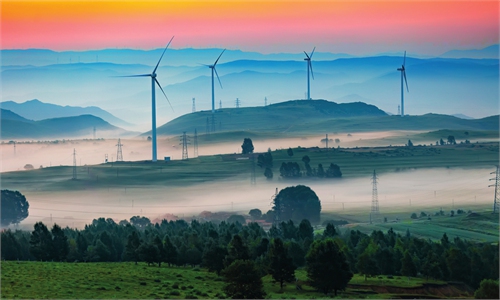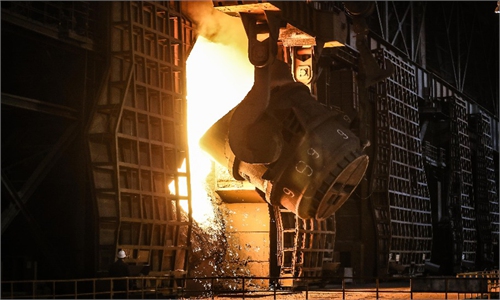China approves Guangzhou Futures Exchange, fifth of its kind in the country
Carbon trading key to 2060 neutrality target

View of piles of coal on a quay in Rizhao, East China's Shandong Province Photo: cnsphoto
China's securities regulator approved the establishment of the Guangzhou Futures Exchange in South China's Guangdong Province on Friday, making it the fifth futures exchange center in China, raising speculation on whether carbon emission allowance futures will become the first trading class to feature on the index.
Apart from the Guangzhou Exchange, China also has the Shanghai Futures Exchange, Zhengzhou Commodity Exchange, Dalian Commodity Exchange and China Financial Futures Exchange.
Approved by the State Council, the China Securities Regulatory Commission (CSRC) officially approved the establishment of the Guangzhou Futures Exchange, which will play a critical role in improving the capital market system, Gao Li, spokesperson for the CSRC, said on Friday.
Gao said the center will also support the construction of the Guangdong-Hong Kong-Macao Greater Bay Area and accelerate high-quality development of the local economy.
South China is famous for its robust manufacturing sector, the Guangzhou Futures Exchange will have a "differentiated development path from the other four futures exchanges," and will enhance market participation by benchmarking the international market, according to China Securities Journal, citing industry insiders.
It is possible that the Guangdong futures trading center will make carbon emission allowance futures its first trading item, Lin Boqiang, director of the China Center for Energy Economics Research at Xiamen University, told the Global Times, adding that a national trading center for carbon emission futures will be necessary for achieving carbon neutrality by 2060.
The establishment of the Guangzhou Futures Exchange has been in the works for two years. At the beginning of 2019, China issued the "Guangdong-Hong Kong-Macao Greater Bay Area Outline Development Plan" and proposed supporting the construction of a green financial reform and innovation pilot zone in Guangzhou, as well as the establishment of an innovative futures exchange.
According to Lin, the attempts to establish a more comprehensive national carbon trading system started three years ago, but once established, it could generate significant carbon emission cuts, especially in major carbon emission industries such as power generation. .
Under the previous carbon trading scheme, a total of 3,443 companies participated in the plan, from a variety of businesses including electricity, aviation and the petrochemical industry. The total trade value reached 5.161 billion yuan ($797 million), trading 218 million tons of carbon dioxide emission.
However, Lin said that during previous trials for carbon trading across eight different cities only "limited fruits," were bore, mainly due to the lack of supervision and unified standards.
"For example, under previous carbon trade trials, a city could emit the carbon dioxide to other places with slacker restrictions or lower carbon emission prices," Lin said, whereas under one national trading system, alternatives to fossil fuels can be made more competitive.
Lin told the Global Times that under the trial scheme, the financial derivatives in the carbon trade market are "very limited", with only a few experimental products in Central China's Hubei Province.
"Since 2014, more derivatives were introduced in places like Beijing, Shanghai and Guangzhou, but market participation remains very low," Lin said.
In a move to roll out a more comprehensive carbon trading system, China's environment authority published pilot rules for carbon emission trading management in early January, days after the launch of the country's national carbon market, a move to further promote China's green, low-carbon development.
The Ministry of Ecology and Environment (MEE) released the "administrative measures for carbon emission trading" on its website, which aims to regulate the carbon trade and related activities within China. It will come into effect on February 1.
According to the newly published trial, companies in the industries covered by the national carbon trade market with annual greenhouse gas emissions of at least 26,000 tons of equivalent carbon dioxide, should be listed as a key greenhouse gas emission unit.
According to China's plan to achieve carbon neutrality by 2060, the country will need to restrict peak CO2 emissions to earlier than 2030.
However, there are still problems to be addressed even when a national carbon emission trading scheme is established, including a more specific pricing mechanism, Ma Jun, director of the Beijing-based Institute of Public and Environmental Affairs, told the Global Times.
"Currently it is still unclear how the price of the carbon emission can be determined, and how much of it should be decided by the market and how much by the government," Ma said, adding that a right price is crucial for the efficient allocation of carbon emission.
"It is certainly a very ambitious plan," Lin told the Global Times, "a national trading scheme on the carbon emission allowance will help the scheme to be more effective in containing carbon emission volume."


